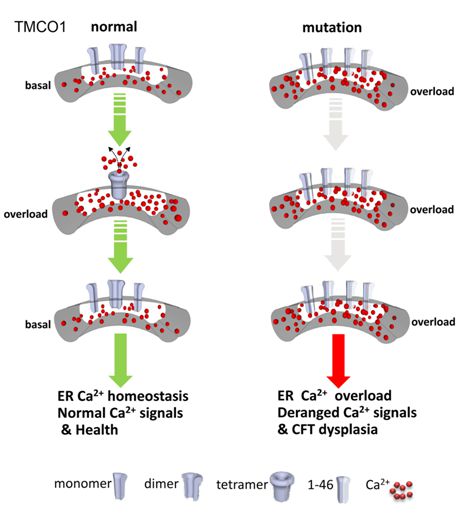Calcium ion (Ca2+) is a highly versatile intracellular signal that controls many different cellular functions such as contraction, secretion, memory formation, gene transcription, cell growth and cell death. Endoplasmic reticulum (ER) is the main intracellular Ca2+ store, and maintaining homeostasis of Ca2+ stores in the ER is crucial for proper Ca2+ signaling and key cellular functions. Disarrangement of ER Ca2+ homeostasis has been implicated in many severe diseases. It is known that Ca2+-release-activated Ca2+ (CRAC) channel is responsible for Ca2+ influx and refilling after store depletion, but how cells cope with excess Ca2+ when ER stores are overloaded is unclear.
In collaboration with Dr. Aimin Zhou in the Department of Chemistry and GRHD at Cleveland State University, Dr. Quan Chen in the Institute of Zoology at Chinese Academy of Sciences, Dr. Yang Li in the Shanghai Institute of Materia Medica at Chinese Academy of Sciences, Dr. Tie-Shan Tang’s team identifies TMCO1 as an ER Ca2+ channel which detects ER Ca2+ overfilling and actively regulates ER Ca2+ content. TMCO1 is capable of sensing the ER Ca2+ overload status, assembling into a Ca2+ channel by homo-tetramerization and thus releasing Ca2+ from ER store. Intriguingly, TMCO1 tetramers rapidly disassemble to terminate the Ca2+ channel activity when ER Ca2+ returns to resting levels. They name this channel as Ca2+ load-activated Ca2+ (CLAC) release channel. The CLAC channel may constitute a conserved mechanism for cell to prevent ER Ca2+ store from overfilling and thus maintain a homeostasis in ER Ca2+ store. TMCO1-defect syndrome mutations result in the CLAC channel disruption, which could be the underlying pathogenic mechanisms for human CFT dysplasia spectrum. Therefore, CLAC functions as a conserved, important regulator of ER Ca2+ homeostasis and thus provides a protective mechanism to prevent overfilling of ER stores with Ca2+ ions.
This work was published in Cell ahead of print on May 19, 2016, doi: 10.1016/j.cell.2016.04.051
Paper link:http://dx.doi.org/10.1016/j.cell.2016.04.051

TMCO1 Is an ER Ca2+ Load-Activated Ca2+ Channel

